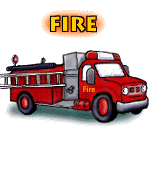|
Volume 6, Issue 15
September 29, 2008
Theme: Fire Prevention Week
A WORD ABOUT THIS ISSUE'S THEME

The theme for the 2008 Fire Prevention Week (October 5-11) is "Prevent Home Fires." The National Fire Protection Association (NFPA) reports that the leading causes of home fires are cooking, heating, and using electrical and smoking (cigarettes, for example) materials. Take time this month to teach your young children the importance of being fire smart and of learning the safety tips that can help them in a fire emergency.
Susan LaBella
Editor, Early Childhood Education Newsletter
ACTIVITY IDEAS

SHOULD I CALL 9-1-1?
Talk with children about using the 911 number when there is a real emergency. Take time to discuss the meaning of a real emergency (illness, accident, fire). Explain to children that if there is a real emergency and there is no one to help them, they should dial 9-1-1. --- Give each child precut numbers 9, 1, 1 and let them glue the numbers onto a large piece of paper. Encourage children to trace the numbers with their fingers.
--- Using toy phones, let children practice dialing 9-1-1. Have children practice saying their names and addresses and reporting an emergency to one another.
CAN YOU FIND IT?
Fill your sensory table with strips of red, yellow, and orange tissue paper. In the tissue paper hide fire-safety items such as toy fire engines, small plastic fire fighters, a toy fire station, a piece of a hose. Also hide items not related to fire safety -- a marble, toy animals, and so on. Let children search and find the fire-safety items. Discuss how each item helps keep people safe from fire.
WHY STOP, DROP, AND ROLL?
Talk with children about what fire needs to burn (oxygen, fuel, heat). Next, light a candle and let children make observations: there is a flame, candle wax is melting, and there is some heat. Ask: What could we take away to put the fire out? Blow on it and explain that you are taking away the heat. Now cover a burning candle with a glass jar and have children count until the flame is out. Explain that you took away oxygen (in the air), which caused the fire to stop burning. Use this experiment to segue into a discussion about using the Stop, Drop, and Roll technique. Explain that by rolling you are taking away oxygen, which stops the fire from burning (as it did with the candle). Finally, show pictures of the correct Stop, Drop, and Roll positions and have children practice them. You might share one of these images so students have a clear picture of what to do before practicing: Stop, Drop, and Roll 1, Stop, Drop, and Roll 2
LET'S MEET
Explain to children that if a fire emergency occurs at home, families need to get out quickly and meet at a safe place outside away from the fire. Brainstorm with children safe places where their families could meet. List student responses on the board (near the mailbox by the street, by the big tree, and so on). Invite each child to draw a picture of his/her house on the left side of a piece of drawing paper and a picture of his/her chosen meeting place on the right side of the paper. Give each child a precut paper doll and have the student practice moving the paper doll from the house over to the safe meeting place. Finally, let children take their pictures home with a brief note from you that encourages families to practice a home fire drill and meet at the chosen "safe place."
CRAWLING LOW
When fire burns, it produces lots of heat and black smoke. Once children begin to understand this, discuss the fact that crawling low under the heat and smoke can help you get out of a burning building safely. Let children practice crawling with this activity. Bring a smoke alarm to school. Divide the class into groups of 3-4 students and turn off the classroom lights. Position a group about 10 feet from the classroom door. Sound the smoke alarm by using the test button and have students practice crawling to the door. Continue until each group has had a turn. Ask: Why do you think it is important to keep your head down when crawling?
ON THE WEB
Check out the following Web sites for additional background and activities.
 Hazard House
Let children click on the eight fire hazards found in the picture. Then talk about why they are hazards.
https://www.usfa.fema.gov/kids/html/hazardhouse/
Firefighter
Get some great information about what a firefighter's job is really like.
https://www.bls.gov/k12/help03.htm
Fire Activity Pages
Printable fire activity pages -- choose one or use them all.
http://www.sproutonline.com/currentSite/firesafety/color.php
Firefighter Protective Clothing Tour
Find out about each part of a firefighter's uniform as you listen to the narrative.
http://www.ci.davis.ca.us/fire/pct/
Arthur's Parent & Teachers Fire Safety
Use this simple lesson plan to teach young children all about fire safety.
http://pbskids.org/arthur/parentsteachers/activities/acts/fire_safety.html
|